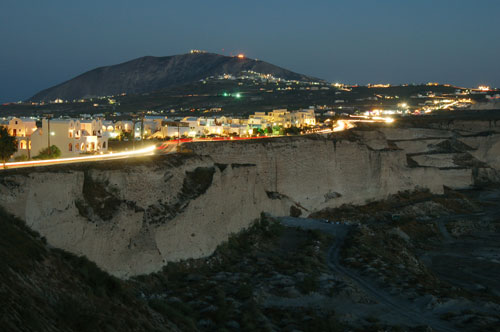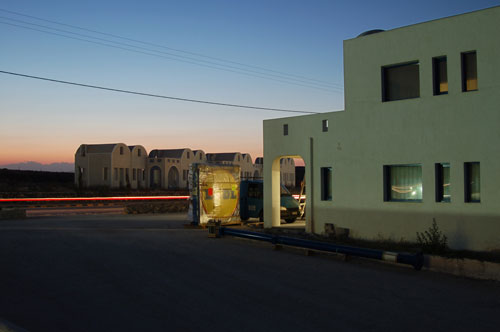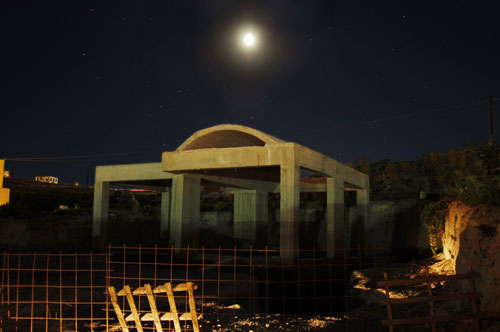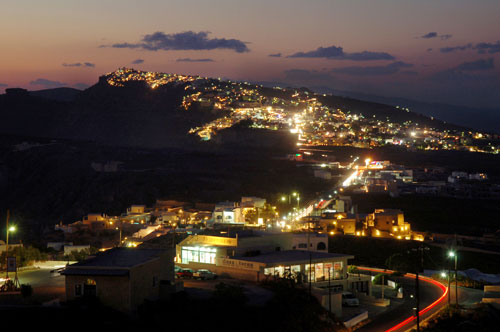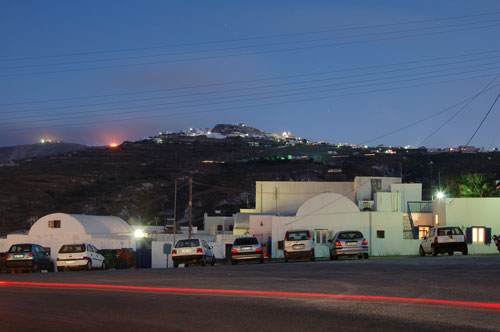Photographing folds
Zoe Hatziyannaki
[1] This essay discusses how Deleuze's theories affected and developed my own photography practice. Being a photographer, I tried to incorporate visual practice with the theory that a PhD requires and came up with some interesting findings on how photography can be used as an imaginative research tool.
[2] My doctoral research dealt with spatial issues in Santorini, Greece. The challenge in one of the case studies I was exploring was to understand and address a rapidly changing landscape characterized by sprawl. How could photography –a traditionally static medium– tackle issues around space and time? The photographs produced seemed visually intriguing and considerably illuminating on the matter I was studying but I did not know how they were actually doing this, how they expressed the fast and arbitrary building expansion. Reading the images through Deleuze's concepts, particularly those of rhizome, fold and speed, enabled me to express not simply what I was searching for but offer a wider reflection on photography and the intricate ways it uses to express time and space.
[3] I will try first to give a more clear idea of the case study. Santorini has been through enormous socioeconomic changes over the last 30 years due to a major and abrupt growth in tourism. The island became 'known' rather rapidly and there was no infrastructure or planning for the immense changes that followed. One of the most evident changes took place in the field of construction. The obvious need for the accommodation of visitors generated initially a relocation of the locals out of their dwellings (then within the traditional settlements) in order to restore them and rent them out. As tourism grew, the locals and other entrepreneurs that came to the island started building new homes as well as shopping areas, banks, etc., outside the old settlements. The wealth that tourism has brought to the island attracted a great amount of immigrants who also needed a home.
[4] The old settlements did not of course remain untouched but were also enormously altered in every aspect – socially (as they changed use, they were emptied out of full-time residents) and structurally, because they went through several alterations, huge expansions and the like. The island's former vernacular settlements are treated as places for consumption; either – and the more likely – they are full of tourist shops, agencies, hotels, restaurants, cafes etc., or as 'museums' more protected as they are bought by wealthy investors and therefore operate only in the summer season and abandoned during winter. The locals who used to reside in those settlements have moved away and no one else really favors them for inhabitation as they are very expensive and have other practical issues that need contending with (access, humidity etc.).
[5] The new dispersed settlements did not follow any particular plan and developed randomly, close to the seashore or near the old ones. Sprawl in Santorini was largely determined by illegality which is the result of a general lack of planning and eventually of the inability to control instances of expediency and favoritism. There are numerous cases where arbitrary decisions are taken by local authorities, where laws are altered or completely overlooked if profit can be gained for members of the local group (a common practice is, for example, for the local council official to issue illegal building permits for votes or for a fee). Consequently, many of the new buildings have authorization problems as they are taller or wider than they should be, too close to the seashore, involving inappropriate architectural elements etc. An indicative example of those semi-illegal states are the multiple unfinished skeleton structures met all over the island which often suggest that there is a legal impediment (the license remains to be issued or it cannot be issued and hopefully with time will be obliterated).
[6] In their majority, the new buildings manifest a need to imitate and acquire a 'modern' way of life which, surprisingly, does not refer to the model of the city, but to the suburban one. They are, most of the time, the homes of locals, indicating their wealth as they are new structures with 'all mod cons,' or they provide accommodation to tourists (hotels, rooms to let), or they simply host banks, shops, and companies.
[7] It must be noted here, that Santorini's vernacular architecture is famous for its exceptional quality based on the relation of the unique natural landscape with the characteristic 'sculptured' houses, excavated completely or partly from the volcanic rock. Most of the newly built houses have very few similarities to their ancestors: they all use reinforced concrete and make use of facets of the neoclassical style, all the while leaving a kind of reminder of the vaulted roof adopted from vernacular architecture. The new constructions demand new roads, which jump out all the time as everyone requires access to their homes, as well as to markets, by automobile. These markets are constructed in the form of a shopping mall and allocated along the road with parking spaces in front. Another important element in the development of sprawl is farmland. In Santorini, agriculture was very important as the land offered the growth and cultivation of unique local products. Even though agriculture was for some years abandoned, it has recently regained very significant ground, thus raising the problem of uncontrolled building expansion.
[8] Sprawl is a product of several different dynamics. Those dynamics have several different forms and speeds which coincide, relate and assemble in various ways, and construct this emerging spatial order – or disorder. Therefore the case of sprawl is not one on its own, detached and different from the rest of the environment. Even though in some cases it is difficult to distinguish where sprawl begins and ends, it is often heard that Santorini has two sides: the front is the scenic and the back is the ugly, that which no one wants to look at. This is a very common binary between the old settlements and the new, namely that of attractive-picturesque-rural/unattractive-banal-urban. But this binary is a completely false one. There is no divide between them, as they are both linked with each other and with everything else. And, what is more, the one is the outcome of the other in their current existing forms: sprawl would not exist if the old settlements had not existed and, accordingly, the settlements would not emerge in the way they do if sprawl had not made its appearance.
[9] This is easier to understand in cases where new constructions-old settlements-countryside become one (as in Fira, the capital of the island); however, the case is the same where those boundaries are distinct (as in Oia village). In the first case, where there is little visual distinction, it is perhaps a bit easier to understand the dependence and the networking between the different elements and their analogous changes, whereas in the second case it is more difficult to realize how a scenic village with luxury hotels is developed in relation to a chaotic unattractive group of buildings nearby.
[10] In any case, the point is to realize that distinctions such as these are false and often dangerous. What would therefore, at first, help create this realization is to think of the formation of sprawl as rhizomatic and not as arborescent – as development horizontally, not as something growing upwards in its own terms. Sprawl is unfolding in a non-linear course, it does not begin in an actual point but in relation with everything else, it is multidimensional and multiform, it has no outside and no inside but moves dynamically between every possible point, creating links, as well as entries and exits: "The fact is that the beginning always begins in-between, intermezzo" (Deleuze & Guattari, Thousand Plateaus 2004: 329). Its surface is rhizomatic forming different levels of intensity, suggesting diverse, even seemingly random, connection points between elements.
[11] The time of day (nightfall) when the photographs were taken in is helpful for the understanding of the rhizomatic structure, as it enables the inscription of different lights which offer the possibility to read relations of apparently quite diverse and irrelevant elements. For example, an unfinished building structure lighted by the lights of a passing vehicle in the middle of a field can suggest alternative associations between those elements and offer the chance to reflect on their complex system of interconnections.
[12] One has merely to think of the several dynamics, cited in the previous paragraphs, which participate and contribute in the structuring and operation of sprawl, such as economic change, traditional values and customs, social relations, legislation, geological and geographical factors, personal preferences, global trends and countless others. All of these suggest a nature of multiplicity, one in which the relative diverse parts intermingle and combine in various ways to create a levelled surface: "...space as 'variable curvature' unfolds or is folded according to a multi-temporality of different co-existing rhythms rather than in linear series of events" (Harris, 2004:43) This rhizomatic nature draws us closer to the idea of the fold.
[13] Deleuze's famous 'Baroque house' is an allegory of a house with two storeys – the first floor has windows and doors so everything from the outside can come in. A staircase leads us to the upper floor where there are no exits, the room is dark. The first floor is the 'living room', it is open to the outside, it is a space of exchange and blending. The second floor is not totally enclosed but not open completely either, it is a kind of selection of the flows, one's own room. All these suggest the multiple foldings and unfoldings of the outside in the inside, of the inorganic in the organic, and the forms they take. The idea of the fold opens up to the subjectivity of space: takes off the material 'burden' without rendering it irrelevant. It does not say that the walls of the house mean nothing, but that they do not mean just concrete boundaries either; they do not separate the outside from the inside as we often think they do. Walls create different relations and accounts of the outside in connection to the inside, they offer translations just as much as the windows do, although through different operations.
[14] The concept of the fold enables us to think of sprawl not as a case apart, distinct from the old towns, villages or landscape, not as the ugly part of the island but in fact as a product of the folding of the one into the other; actually of multiple foldings of all kinds, a space of constant exchange with flows and dynamics and as such a space of flux, to such an extent that it might be said that this space is the stairway of the 'Baroque house':
They are the fold in the proper sense: neither inside nor outside, neither body nor thought, but something that emerges when both body and mind leave themselves; neither the light of the day nor the night of the dark chamber, but the dawn. If the stairs are both of those things at the same time it is because they are in-between them: they are the space or the embodiment within a space of a pure relation. (Arsic, 2004:134-135)
Sprawl in Santorini is in-between past and present forms, the personal and the public, local and global, nature and culture, natural and artificial, territory and chaos. All the above reveal a fast-changing spatial order where unknown and exceptional facts and circumstances enter the game and new, unvisited situations are introduced. We have assemblages of considerably heterogeneous elements: their interplay, their forming and unforming and their passing from one to another produces a multiform and multidimensional space.
[15] The photographs offer examples of this multidimensionality through the relation of architecture and landscape that they propose. Grosz (2001) suggests that architecture is always in-between culture and nature. Architecture is an amalgam of both equally even though its cultural side has been much more or solely considered, as if nature is a passive element that does not interfere. The elements of nature (climate, geography, geology) are not something that architecture can ignore nor suppress but are strong formative elements that it has to intermingle with. In some of the photographs I believe one is able to trace this exchange, the foldings and unfoldings of nature and buildings and follow the flexible boundaries and (yet) undefinable areas that they create. What is also worth suggesting in connection to this idea is the time of the day depicted in the images. All the photographs are taken during nightfall. Like the 'stairs' of the Baroque house, they are 'neither the light of the day nor the night of the dark chamber, but the dawn' (2004:134). The hour of dusk can hopefully express the in-betweeness (of culture and nature) within the spatial reality examined, sprawl not being this or that, or here or there but a pure relation, an atmosphere, an aura, a passage. (2004:132).
[16] Most interesting of all, I think, is to investigate the possible ways that photography expresses speed, that is, the fluidity of the space examined in this case study. Duration is inscribed in the photograph, although differently than it is in the moving image. In a photograph the space-time relation opens up through intricate and interesting ways. Mobility does not suggest a movement from one point to another but is rather a result of relations between things: movement(s) of one object or subject determines and is determined by the movement(s) of the other. What a photograph does foremost is depicting relative movements generated between the duration that the shutter speed remains open and the duration(s) of that which is photographed. This 'quality' of the photograph is useful because it can also suggest a non-linear reading of space. Meaning, that a photograph can provide a plane where relative movements are drawn, where one is able to trace the various associations between the elements and imagine a mobile map of flows. This plane can be understood as the 'phase space': the sum total of the system's movements and moments contracted into the same set of diagram coordinates. (Massumi, 1992:67)
[17] What is more, a photograph lacks linear narration; there is no implication of a beginning or an end, no prescription of how one should read time. This allows for an apprehension of space directly through the relations and transitions of the elements that constitute it. A photograph can unfold a complex reality, a (transient) state of things freed from the restrictions of linear time which can often mislead by imposing a chronological order in which those states occur. This order is deceptive as it, first of all, implies a past, a present and a future –an ambiguous notion challenged by Deleuze (Cinema ΙΙ, 2005:80). That is not to say that photographs provide a timeless a-historical view, but on the contrary offer a chance to experience time and space immediately through the rhythms and flows that produce them.
[18] The nightfall series of photographs I am presenting are another way of suggesting this intricate relationship between time and space. Even though photography is not considered the appropriate medium for representing duration, as it is associated with the arrest of time, this 'instant' has, however, a duration. It is the duration of the shutter speed which controls the amount of time the shutter remains open in order to allow the light to come through. Different visual results are produced depending on the duration of the exposure. In this series the lights of the moving cars have created colored lines. Those lines 'draw' the amount of time that the shutter stayed open, which is also the distance the vehicles have covered during this time. The exposure time is the time of space. The lines inscribe the speed. But the speed of what? The speed of the shutter or the speed of the cars? The answer is both shutter speed and vehicle speed. The lines are flows of light that are in-between the exposure time and the space time. The photographs can also evoke similar readings of space through the 'writing' of the automobiles' lights. The 'lines' of the lights can evoke this idea of fluidity and in a way manage to translate time into space.
[19] There is, however, an inconsistency in this discussion about the speed(s), as the lines we are talking about are immobile. In the photographs, speed is implied through what is thought of as its opposite: immobility, instance. The current discussion is one of absolute speed. Deleuze and Parnet (2006:30-31) suggest that the notion of speed is very complex: It is not about fastness or about change. Absolute speed is not a developing process but something which is immanent, existing always in-between, in the middle:
We must distinguish not relative and absolute movement, but the relative and absolute speed of any movement. The relative is the speed of one movement considered from the point of view of another. But the absolute is the speed of movement between the two, in the middle of the two, which traces a line of flight. Movement does not go from one point to another –rather it happens between two levels as in a difference of potential. A difference of intensity produces a phenomenon, releases or ejects it, sends it into space.
This is the speed we are dealing with in those photographs, a speed which is the outcome of many different speeds (of the shutter and the cars, as well as of the speed of the light of day etc.), and this speed can be immobile. Absolute speed is like a fixed plane capable of including and portraying all interaction at the same time. It is an instance of immobility, of rest.
[20] Photography can be a fixed plane – not in the sense that every movement is stopped, but on the contrary in the sense of an all-inclusiveness, as the concentration of all folds and movements – that which can make us perceive everything at the same time, in other words a phase-space, and, in this case, its static nature is not a constraint but an exceptional force. This means that photography can indeed offer a perception of our world through the networks, flows and movements that characterize it and produce it and thus enable its comprehension as a whole, as an incessantly folding interconnected universe.
[21] So what does this collaboration of theory and photography practice offer to the understanding of the case study? And in what ways could this understanding prove helpful? The recognition of space as a mobile set of relations and flows is what provides the case study with different and valuable angles of approach. This recognition offers the chance to acknowledge and assess differently the parameters that constitute many problematic cases – sprawl, for instance. They are problematic because instead of allowing the dynamic nature of those parameters to make the innumerable relations of which they are capable, they instead oppress this capacity and discourage the production of relations. This oppression is put into work through processes of categorisation and distinctions which can have many different forms and applications and, of course, different results.
[22] Categorisation is, in short, the cut between relations, their denial, a detention of movements between substances. The operations of categorisation are deterrent because they deprive a place (as well as a person, an animal, an object, an idea) of its dynamic and multiple nature(s). Its processes often emanate from and stand on rigid concepts like those of a fixed and fragmented time and space, constructing abstract images of an intact (from civilization) nature or of a glorified and idealised past. Instead, then, of dealing with space's (and every substance's) inner qualities, that is, as products of multiplicity and change, they treat it as static and segmented. This treatment of space results in the construction of binary systems, often between old-new, beautiful-ugly, nature-civilization etc. These binaries are products of spatial and temporal fragmentations which prevent the multiple and various relations and interplays of variegated forces.
[23] In conclusion, the apprehension of space as fixed and split entities has, in my opinion, led to many serious problems in Santorini (and other tourist destinations). In the current case problems are created because of arbitrary categorisations of areas (and people) which lead to serious dysfunctions in environmental, social or simply aesthetic matters.
[24] A possible way out of such impulses to categorisation is, for a start, to simply think of space as a continuous relation, to not allow for any fixations or for any exclusions. The effort is to appreciate Santorini within the movements and networks that construct it at present: only if it is considered in correlation not just with every other place to which it is physically or non-physically temporarily related, but with every other subject, object, sound, feeling, fantasy as well. It is in this context that the appreciation of the photographs through Deleuze's concepts prove helpful as they make it possible to realize the case as a relational shifting whole. In other words they urge us to construct and invent new mobile 'maps' of Santorini through the revelation of these multiple relations and their intensities.
Works Cited
Arsic, Branka (2004) 'Thinking Leaving' in Deleuze and Space, eds. Buchanan, Ian and Gregg Lambert. Edinburgh, University Press.
Deleuze, Gilles (2005) Cinema II. London, Continuum.
Deleuze, Gilles and Guattari, Félix (2004) A Thousand Plateaus: Capitalism and Schizophrenia. London, Continuum.
Deleuze, Gilles and Parnet, Claire (2006) Dialogues. London, Continuum.
Grosz, Elizabeth (2001) Architecture from the Outside. Cambridge, Mass., MIT Press.
Harris, A.Paul (2004) 'To See with the Mind and Think through the Eye: Deleuze, Folding Architecture, and Simon Rodia's Watts Towers' in Deleuze and Space eds. Buchanan, Ian and Lambert, Gregg. Edinburgh, University Press.
Massumi, Brian (1992) A User's Guide to Capitalism & Schizophrenia, Massachusetts, MIT Press.

